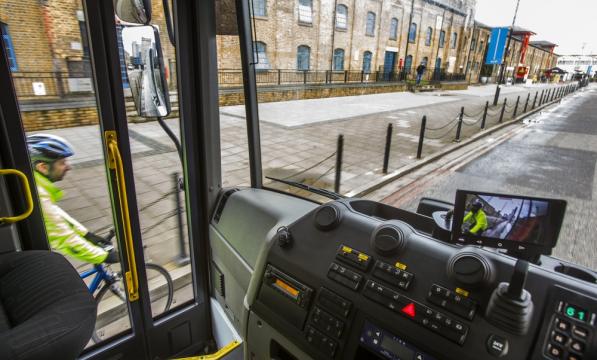Ban unsafe lorries from London if standards not met

CTC, the national cycling charity, has voiced support for proposals from Transport for London (TfL) to require lorries in London to have windows fitted in the left-hand side-door, but has also called for more ambitious plans to make 'direct vision' lorries the norm, allowing lorry drivers to see cyclists and pedestrians as easily as bus drivers can.
Despite making up 4% of London traffic, lorries are disproportionately involved in London cyclists’ deaths. Between January 2008 and July 2015, 56 of the 99 cyclists killed in London were involved in collisions with lorries.
CTC's views are set out in its response to a TfL consultation on extending its Safer Lorry Scheme. This scheme was introduced on 01 September 2015 and requires lorries to be fitted with side guards and extended side-view mirrors. The latest consultation calls for further improvements with glass vision panels in the passenger side doors. This will improve drivers’ direct vision of vulnerable road users on the cab’s left hand side.
While supporting this positive step towards greater cyclist safety, CTC is also calling for TfL and all 33 London boroughs initially to express a preference towards direct vision lorries in all future bids for planning applications and publicly-funded contracts, then move progressively towards banning lorries without direct vision designs from London's roads.
Unlike traditional lorry cabs, direct vision lorries give drivers a lower seating position in the cab and surround them with more window area, allowing them a view of what's around them similar to that of a bus driver.
CTC believes TfL should set out a road map for direct vision lorries to become the norm, [...] eventually banning any remaining lorries without direct vision cabs by 2025.
Duncan Dollimore,
CTC Road Safety Officer
CTC believes TfL should set out a road map for direct vision lorries to become the norm, making their use mandatory for new developments and publicly funded contracts by 2020, then eventually banning any remaining lorries without direct vision cabs by 2025.
CTC is inviting supporters to back its lorry safety proposals by emailing TfL using CTC’s online tool at: www.ctc.org.uk/saferlorries.
Duncan Dollimore, CTC’s Road Safety Officer, said:
“With London lorry traffic set to increase as Crossrail comes to completion and HS2 starts in earnest, TfL’s consultation on improving lorry safety is a timely step in the right direction. However, more can and must be done to protect vulnerable road users, not just in London but around the rest of the country too.
“CTC is urging TfL to set out a road map for the adoption of direct vision lorries. They and other public bodies could start by encouraging lorry firms who operate in London to adopt these lorries, as a first step towards removing all unsafe lorries from our roads. We hope this would rapidly spread to the whole country.
“Cyclists and anyone else wishing to support these proposals can do so via the CTC website at www.ctc.org.uk/saferlorries."
Notes to editors
CTC, the national cycling charity, inspires and helps people to cycle and keep cycling, whatever kind of cycling they do or would like to do. Over a century’s experience tells us that cycling is more than useful transport; it makes you feel good, gives you a sense of freedom and creates a better environment for everyone. www.ctc.org.uk
- CTC’s full consultation response is available at: https://www.ctc.org.uk/sites/default/files/media_library/users/SamJones…
- Public supporters of CTC’s consultation response can write to TfL via the CTC website: www.ctc.org.uk/saferlorries
- TfL’s presentation ‘Safer trucks in London’ which explains their research ‘High Vision HGV Evaluation – Phase 1’ is available for download here. The presentation features feedback from lorry drivers who have used direct vision lorries on slides 11 and 12 indicating industry approval.
- During the construction phase of the HS2 rail terminal at Euston, lorry movements on Camden's streets alone are expected to reach a peak of 1,440 per day.
- Further information on direct vision lorries can be found on the Mercedes and Dennis Eagle websites: https://www.sbcommercials.co.uk/article/mercedes-benz-econic-direct-vis… and http://www.dennis-eagle.co.uk/
Press contact information
CTC Press Office
Email: publicity@ctc.org.uk
Telephone: 01483 238 315

